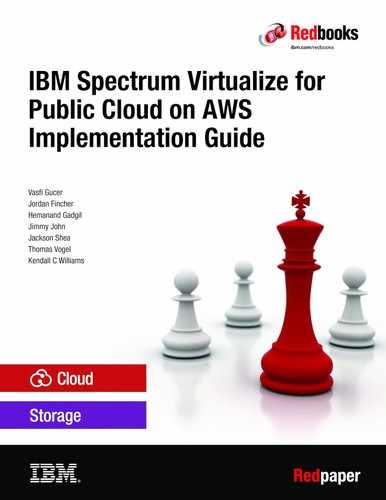

Supporting the solution
This chapter provides guidance about how support for this solution is put together. This solution is made up of two basic support segments:
•Amazon Web Services (AWS)
•IBM Storage support teams.
It is important to understand who to contact if a problem occurs.
In this chapter, the following topics are described:
6.1 Who to call for support
The IBM Spectrum Virtualize for Public Cloud on AWS solution is composed of several components, much like the traditional storage offerings. However, when deployed in the public cloud on AWS, IBM Spectrum Virtualize is simply an application running in a stack on AWS Cloud. So, to ensure that your level of support matches the level that is required to support your application, see AWS Support to see the various levels of support that are available to an AWS user.
In this solution, the cloud provider is responsible for providing the infrastructure, network components, storage, support, and assistance for this solution. The cloud user or any involved third parties are responsible for deploying and configuring the solution from the network layer up to the operating system, and the software that is installed. IBM Systems Support is responsible for providing support and assistance with the IBM Spectrum Virtualize application.
The solution is composed of multiple parties with different roles and responsibilities. For this reason, it is a best practice in such cross-functional projects and processes to clarify roles and responsibilities by using a workflow definition that handles tasks and problems when they arise. In this sense, a responsibility assignment matrix, also known as a RACI matrix, describes the participation by various roles in completing tasks or deliverables for a project or business process. (RACI stands for Responsible (R), Accountable (A), Consulted (C), and Informed (I).
The RACI matrix is specific for each solution deployment: How the cloud service is provided, who the final user is, who are the multiple parties that are involved, and so on. To help create a workflow for handling problems when they arise, use Table 6-1 as an example of an RACI matrix.
Table 6-1 Simplified workflow definition based on an RACI matrix
|
Situation
|
Client
|
Cloud provider
|
IBM Spectrum Virtualize
|
|
IBM Spectrum Virtualize error 2030.
|
Informed
|
Consulted
|
Responsible
|
|
Managed disk (MDisk) is offline.
|
Informed
|
Responsible
|
Accountable
|
|
Network port is down.
|
Informed
|
Responsible
|
Consulted
|
|
Configuration question.
|
Responsible
|
Consulted
|
Accountable
|
In situations where the cloud provider is responsible or accountable, the client should collect as much detail about the problem that is known and open a ticket with the cloud provider. In the situations where IBM Spectrum Virtualize is responsible or accountable, the client should collect as much detail about the problem and diagnostic data surrounding the event and open a Problem Management Record (PMR) with IBM. In situations where the client is responsible, it is up to the client to be as detailed as possible in any requests or questions that are raised to the cloud provider, IBM Spectrum Virtualize, or any other third party that is involved in the support.
6.2 Working with AWS support
AWS is a service that provisions the infrastructure, network, operating systems, and back-end storage that is used in this solution. AWS support is responsible for helping resolve problems and answer questions for products and services that are acquired through the AWS Marketplace Console.
The AWS support team is engaged by opening a case that provides support for any related problems and questions if the IBM Spectrum Virtualize Software cannot run successfully.
Figure 6-1 shows where you can open a case in the AWS Marketplace support center.

Figure 6-1 Accessing the support center by using the AWS Marketplace Console
In this page, you can create a case, as shown in Figure 6-2.

Figure 6-2 Create a case by using the AWS Support Center
There are three types of cases that can be open with AWS Support. Our focus is on technical support, as shown in Figure 6-3.

Figure 6-3 Type of cases that can be opened with AWS Support Center
In this page, you see a form to complete regarding the problem, as shown in Figure 6-4.

Figure 6-4 Submitting a case
After adding your case subject and description, you have three options to engage with AWS support, as shown in Figure 6-5.

Figure 6-5 Options for engaging with AWS support
If a technical issue cannot be resolved through a chat with a representative from AWS support, you can check the status of the case in the My support cases tab, as shown in Figure 6-6. An email is sent to the master account and to all the customer representative accounts that are assigned to the ticket or entitled to receive it. The accuracy of email addresses must be verified in advance for the correct functioning of email notifications.

Figure 6-6 Checking the existing support cases in AWS Support Center
The Case history page shows a list of existing and previous cases, as shown in Figure 6-7 on page 101.

Figure 6-7 List of existing cases
In this window, an individual case can be selected by clicking the case subject or the case ID. When viewing an existing case, you can review the status, submit an update to the cases, and mark a case as resolved, as shown in Figure 6-8 to progress with the support interaction.

Figure 6-8 Reviewing a specific case
..................Content has been hidden....................
You can't read the all page of ebook, please click here login for view all page.
